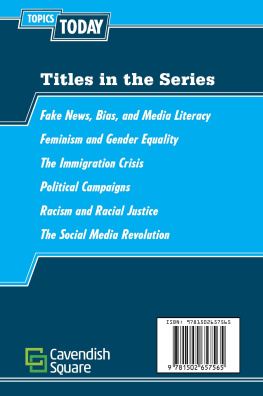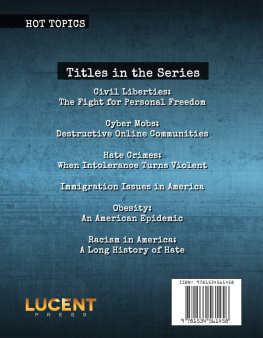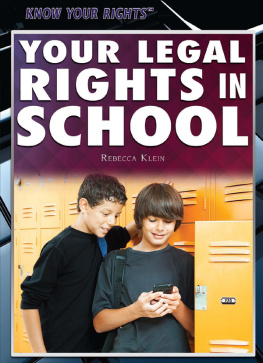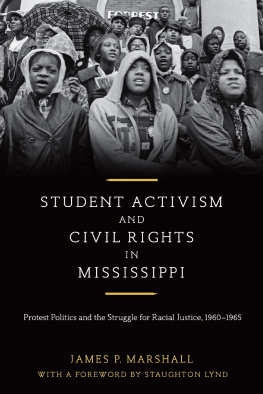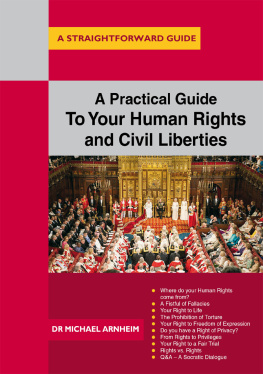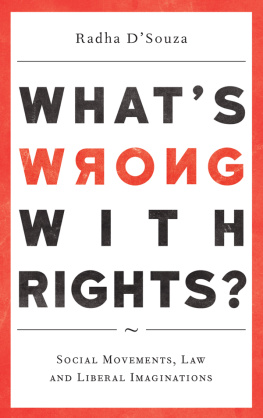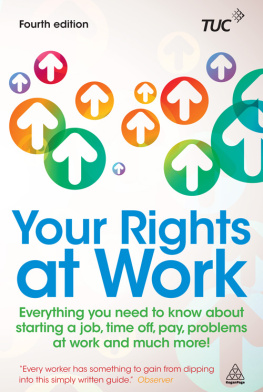
Published in 2020 by
Lucent Press, an Imprint of Greenhaven Publishing, LLC
353 3rd Avenue
Suite 255
New York, NY 10010
Copyright 2020 Greenhaven Press, a part of Gale, Cengage Learning
Gale and Greenhaven Press are registered trademarks used herein under license.
All new materials copyright 2020 Lucent Press, an Imprint of Greenhaven Publishing, LLC.
All rights reserved. No part of this book may be reproduced in any form without permission in writing from the publisher, except by a reviewer.
Designer: Andrea Davison-Bartolotta
Editor: Jennifer Lombardo
Cataloging-in-Publication Data
Names: Collins, Anna.
Title: Student rights in a new age of activism / Anna Collins.
Description: New York: Lucent Press, 2020. | Series: Hot topics | Includes index.
Identifiers: ISBN 9781534568167 (pbk.) | ISBN 9781534568174 (library bound) | ISBN 9781534568181 (ebook)
Subjects: LCSH: Students-Legal status, laws, etc.-United States-Juvenile literature. | Students- -Civil rights--United States--Juvenile literature. | Educational law and legislation--United States--Juvenile literature. | Student movements--Juvenile literature.
Classification: LCC KF4150.C65 2020 | DDC 344.730793-dc23
Printed in the United States of America
Some of the images in this book illustrate individuals who are models. The depictions do not imply actual situations or events
CPSIA compliance information: Batch #BW20KL: For further information contact Greenhaven Publishing LLC, New York, New York at 1-844-317-7404.
Please visit our website, www.greenhavenpublishing.com. For a free color catalog of all our high-quality books, call toll free 1-844-317-7404 or fax 1-844-317-7405.
CONTENTS
FOREWORD
A dolescence is a time when many people begin to take notice of the world around them. News channels, blogs, and talk radio shows are constantly promoting one view or another; very few are unbiased. Young people also hear conflicting information from parents, friends, teachers, and acquaintances. Often, they will hear only one side of an issue or be given flawed information. People who are trying to support a particular viewpoint may cite inaccurate facts and statistics on their blogs, and news programs present many conflicting views of important issues in our society. In a world where it seems everyone has a platform to share their thoughts, it can be difficult to find unbiased, accurate information about important issues.
It is not only facts that are important. In blog posts, in comments on online videos, and on talk shows, people will share opinions that are not necessarily true or false, but can still have a strong impact. For example, many young people struggle with their body image. Seeing or hearing negative comments about particular body types online can have a huge effect on the way someone views himself or herself and may lead to depression and anxiety. Although it is important not to keep information hidden from young people under the guise of protecting them, it is equally important to offer encouragement on issues that affect their mental health.
The titles in the Hot Topics series provide readers with different viewpoints on important issues in todays society. Many of these issues, such as students rights, are of immediate concern to young people. This series aims to give readers factual context on these crucial topics in a way that lets them form their own opinions. The facts presented throughout also serve to empower readers to help themselves or support people they know who are struggling with many of the challenges adolescents face today. Although negative viewpoints are not ignored or downplayed, this series allows young people to see that the challenges they face are not insurmountable. As increasing numbers of young adults join public debates, especially regarding their own rights, learning the facts as well as the views of others will help them decide where they standand understand what they are fighting for.
Quotes encompassing all viewpoints are presented and cited so readers can trace them back to their original source, verifying for themselves whether the information comes from a reputable place. Additional books and websites are listed, giving readers a starting point from which to continue their own research. Chapter questions encourage discussion, allowing young people to hear and understand their classmates points of view as they further solidify their own. Full-color photographs and enlightening charts provide a deeper understanding of the topics at hand. All of these features augment the informative text, helping young people understand the world they live in and formulate their own opinions concerning the best way they can improve it.
INTRODUCTION
The Evolution of Education
I n the United States, the rights of people under the age of 18 are a hotly debated and frequently misunderstood topic. Some adults believe that since students have to abide by the rules their schools and parents set, they have no right to challenge any of those rules. Students themselves may also feel that they do not have any rights, especially when schools overreach their boundaries and try to suppress their students rights. In reality, certain rights are protected for students by the U.S. Constitution. What exactly are these rights, and what can students do when they are violated?
Access to Education
Historically, the first debate about student rights arose over the question of whether everyone was entitled to a public education. As understood today, public education means schooling provided by the government and paid for by taxes; however, public education in America arose out of an early union between the church and the state. The Puritans of the Massachusetts Bay Colony during the 17th century started the first state-sponsored schools, whose curriculum combined religious and academic instruction for all boys and occasionally for girls. The oldest continuously operating public school in the United States is the Boston Latin School, which was founded in 1635. Outside of Puritan Massachusetts, though, religious diversity and class division made public education more challenging. Male children of wealthy landowners were the only ones who consistently received an education; if schools did not existwhich was the case in many colonies at that time, especially in the Souththese male children were tutored at home. Girls and women, poor children, indentured servants, and slaves often went without any formal schooling. When girls did receive an education, the emphasis was placed on what they needed to know to be good wives and mothers; for example, they were often taught how to read but not how to write. In contrast, boys were taught subjects that would help them find a good career later in life.

The Boston Latin School (shown here) is considered one of the best schools in Massachusetts. In the past, it was only open to white male students, but today, girls account for 54 percent of the student body, and people of color account for 53 percent.
It was not until the Revolutionary period that a pioneering education agenda began to take shape. At this time, a new enthusiasm for civic duty to ones community outweighed the traditional emphasis on religious training that dominated schools for so many years. Influenced by the writing and ratification of the U.S. Constitution, American education began to take shape as a way to achieve national unity. It was at this time that common schools, which educated students of all ages in one room with one teacher, began to emerge. According to the American Board for the Certification of Teacher Excellence, Students did not attend these schools for free. Parents paid tuition, provided housing for the school teacher, or contributed other commodities in exchange for their children being allowed to attend the Since money was not the only way for parents to pay for their childrens education, even poor students could attend school, although they may not have done so consistently if they were needed at home.
Next page

